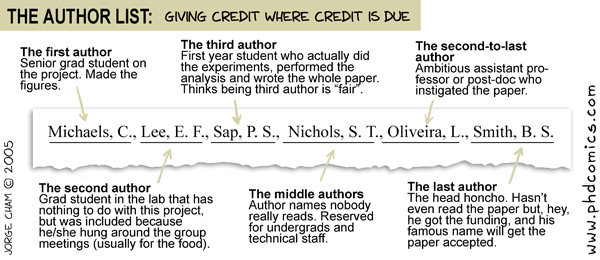Author: Rafael Repiso – Translation: Erika-Lucia Gonzalez-Carrion
Addressing authorship is a complex issue on which a thesis could be written, as the uses and practices have been changing throughout history and currently diverge between different scientific fields. That is why this entry only intends to undertake a general introduction focused on the field of Social Sciences. In this post we will focus on answering three questions, how many sign, who should sign and in what order. We will not remember the advantages of working in a team.

Is the number important? Of course, the numbers are palpable reflections of reality and can be interpreted. Should there be a closed number of authors for each work? No, as the utopian socialists would say «To each one according to his/her needs» (the needs of the article, it is understood), that is, the complexity of the work is the main element that justifies the number of people who have carried it out and therefore signed . However, caps have been established for scientific evaluations. For example, in areas where the work comes largely from the author’s reflection (Philosophy, Law, etc.), it is usual for the work to be performed alone, both research and writing. In other areas where working with large teams or even interdisciplinary and international research is very common, the number of signatories can go to hundreds of jobs, this is common in areas such as Applied Physics, Astrophysics, etc. In Social Sciences it is frowned upon that the co-authorship exceeds the four authors.
So what is the proper number? Well, as we said at the beginning depends on the complexity, what can justify the difficulty of a job? Basically three issues; 1. the size and characteristics of the object of study, 2. the multiplicity of theoretical and methodological disciplines from which the research is addressed and of course 3. the final length of the work. There is a very interesting article by Nicolás Robinson and Carlos Benito Amat in which they analyze the meaning of the sense of the limitations in the number of authors imposed by the evaluation organizations and do so with data, showing how the articles with the greatest scientific impact usually have a number of authors above what is allowed (Robinson-García and Amat, 2018). By the way, if you still want to know what is normal in each field, there is a very interesting product from the Google Scholar division of the EC3 group in which you can consult the basic descriptions by areas, journals and years. Co-Author Index http://www.coauthorindex.info/layout.php?id=inicio
Who should sign a paper?
A work must be signed by everyone who has made a substantial contribution to it, whether in the process of searching for data, analyzing or writing results. Of course, every author who signs a scientific work must give his / her approval to the final work and his/her position in the group of co-authors. There are figures which, having collaborated, do not have to sign, since they have been paid for that collaboration (translators, laboratory technicians, etc.). Also, when a third party makes a specific and determined contribution (a review of a specific section, a theoretical or methodological clarification) it is common to review this help in the «Acknowledgments» section, an example may be to thank the reviewers of the work if they have made an improvement to it. Be very careful with the imposition of ghost authors by some of the co-authors (especially those who hold academic power). This is a source of problems in the short, medium and long term that does nothing but fills the university with useless people who say they are experts in jobs that others have done.
In what order to sign? (Of each according to their abilities). The meaning of the order of the signature varies according to the areas. For example, in the area of Mathematics the order of the signatures is limited to an alphabetical criterion, therefore, the attribution of the value of the work is distributed equally between each author, since mathematicians take great care not to collaborate with other researchers unless it is essential. Social Sciences have endorsed the uses of Biomedicine where the order of the authors implies different roles and workloads in the development of the article. Therefore, in this system the positions reflect the role of each of the authors and the order the involvement in the work:
First author: He/She is the main author of the document, normally the one who has had the idea and has developed it in all phases of the document, the one who has coordinated the work of the other authors and is usually the one who has done the complete writing of the document, adapting the contributions of the others.
Last author. Sometimes the last author is the most established scientist of the group, project manager, director of the first author’s thesis, etc. His/her work is that of final reviewer before the manuscript is sent, normally the proposed work is that of a project led by him/her.
Other authors. According to the involvement they have had at work, they appear, first those who have worked the most or have performed substantial functions. It would be a simplicity to quantify work according to the number of hours spent (as utopian socialists do) without taking into account aspects such as complexity or creativity.
Punctual collaborators. Those who have collaborated in isolated and specific aspects of the research can be included in the «Acknowledgments» section without having been involved in the whole of the research or the writing of the manuscript, especially if their collaboration was remunerated.
Of course remember that Robinson-García, N. and Amat, C.B. (2018). Does it make sense to limit scientific co-authorship? There is no inflation of authors in Social Sciences and Education in Spain. Spanish journal of scientific documentation, 41 (2), 201.
